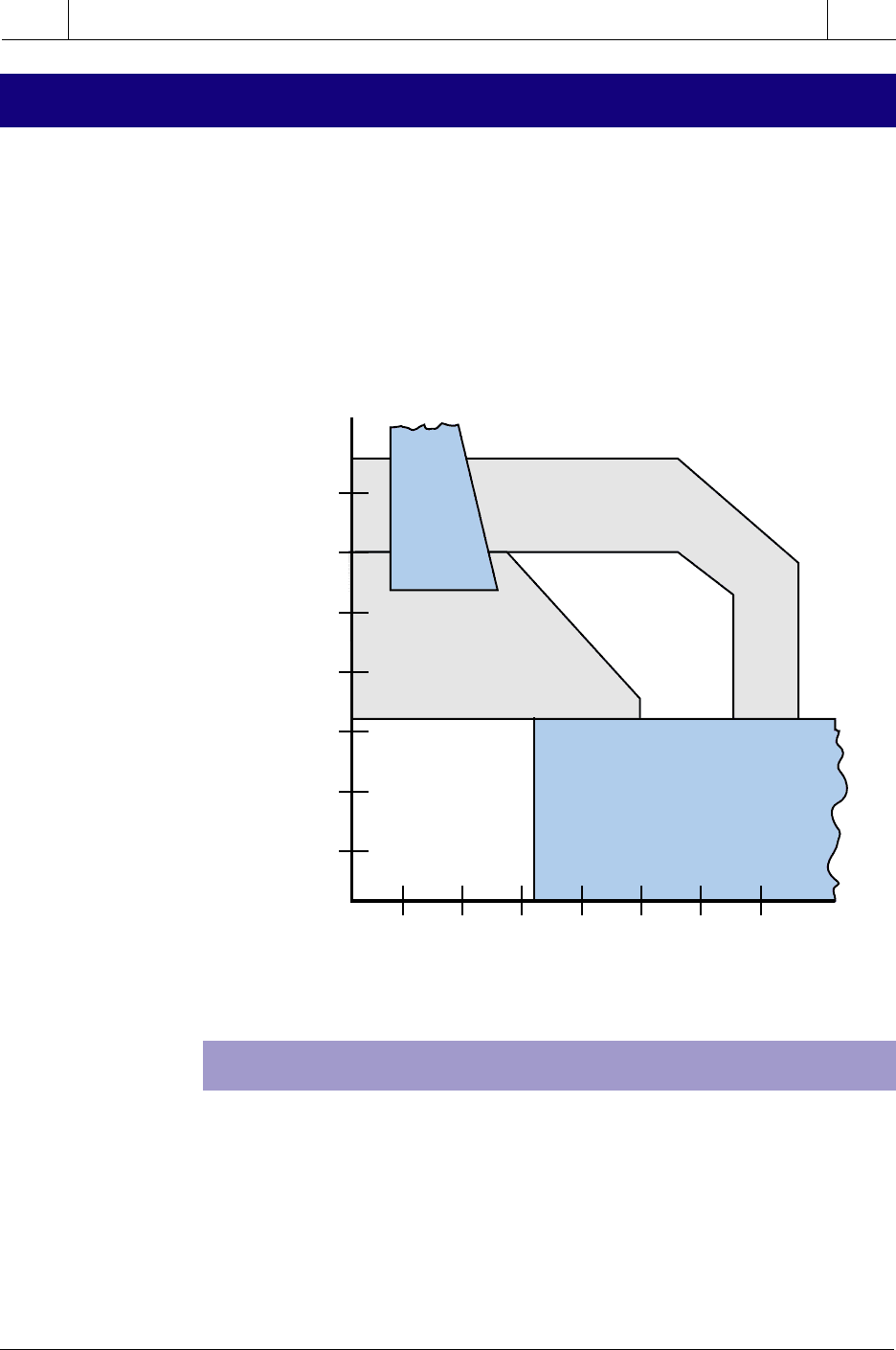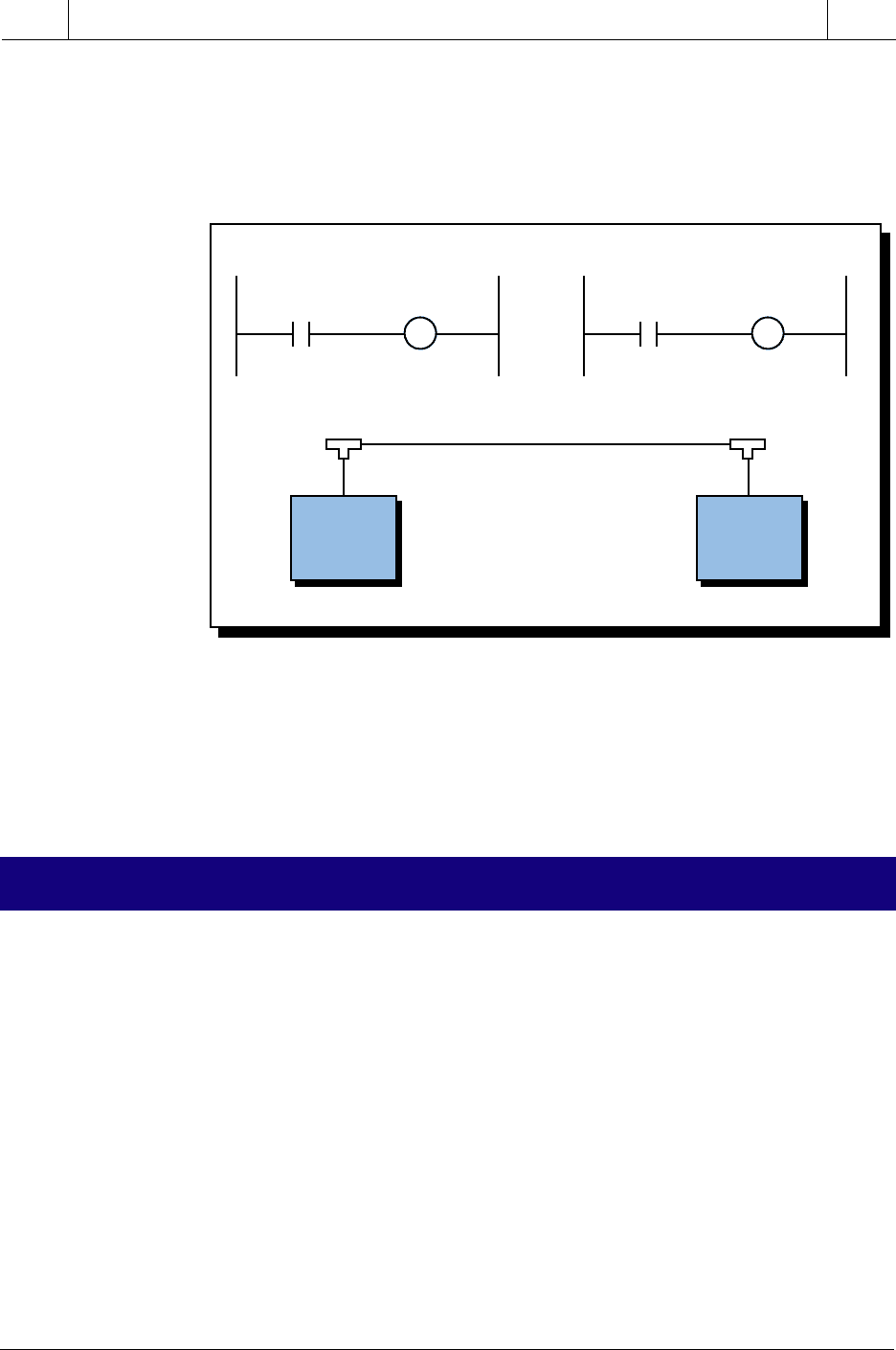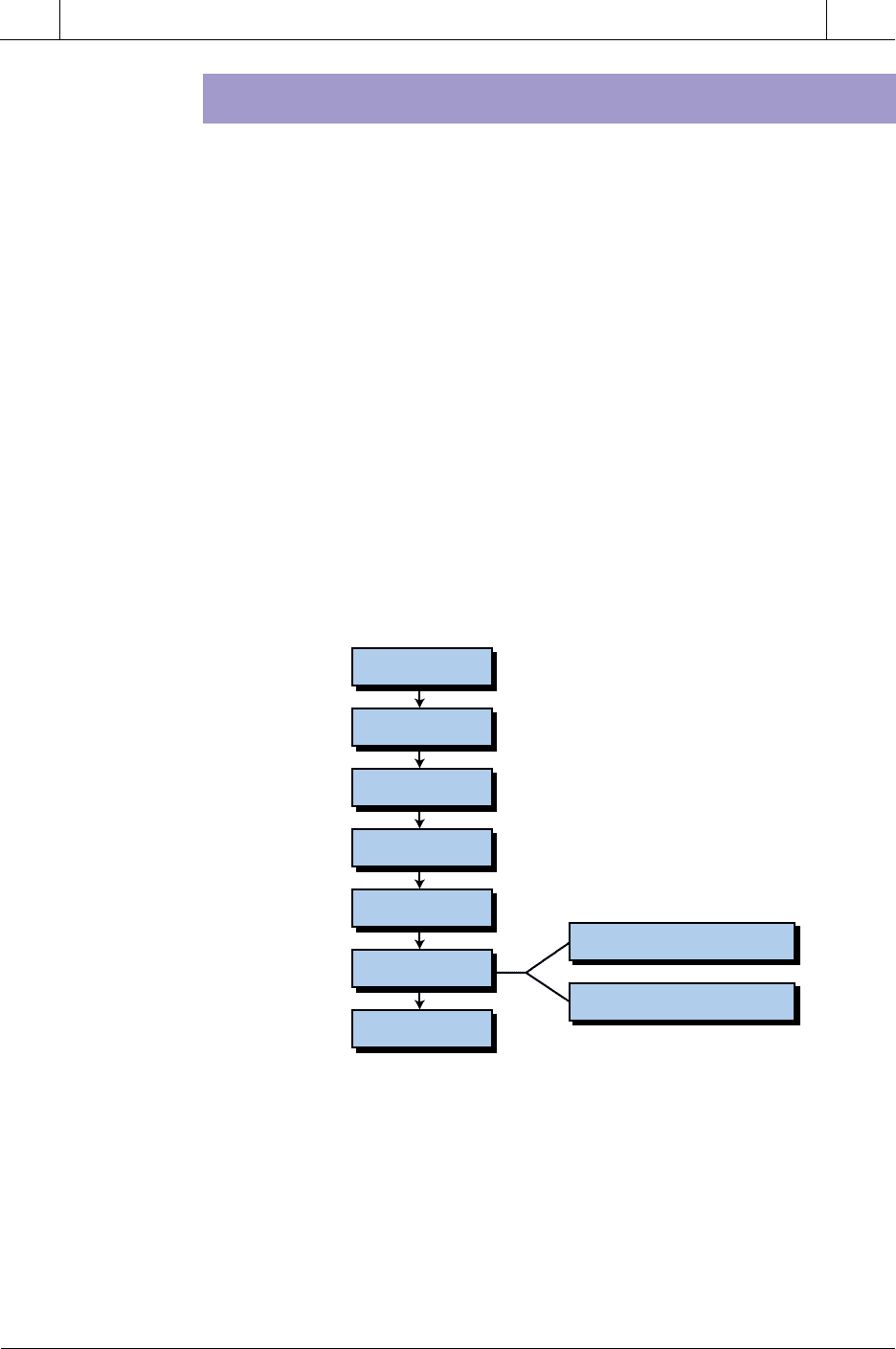Bryan L. Programmable controllers. Theory and implementation
Подождите немного. Документ загружается.


859
CHAPTER
18
Local Area
Networks
SECTION
5
Advanced PLC
Topics and Networks
Industrial Text & Video Company 1-800-752-8398
www.industrialtext.com
temporary, right to control the network (i.e., transmit information). The
station with the token has the exclusive right to transmit on the network;
however, it must relinquish this right to the next designated node upon
termination of transmission. Thus, token passing is actually a distributed form
of polling. The token-passing access method is preferred in distributed control
applications that have many nodes or stringent response time requirements.
In a common bus network configuration using the token-passing technique,
each station is identified by an address. During operation, the token passes
from one station to the next sequentially. The node that is transmitting the
token also knows the address of the next station that will receive the token.
The network circulates transmitted data in one or more information packets
containing source, destination, and control data. Each node receives this
information and uses it, if needed. If the node has information to send, it sends
it in a new packet.
In the token-passing scenario shown in Figure 18-11, station 10 passes the
token to station 15 (the next address), which in turn passes the token to station
18 (the next address after 15). If the next station does not transmit the token
to its successor within a fixed amount of time (token pass timeout), then the
token-passing station assumes that the receiving station has failed. In this
case, the originating station starts polling addresses until it finds a station
that will accept the token. For instance, if station 15 fails, station 10 will
poll stations 16 and 17 without response, since they are not present in the
network, and then poll station 18, which will respond to the token. This
receiving station will become the new successor and the failed station will be
removed from, or patched out of, the network (i.e., station 18 will become
station 10’s next address). The time required to pass the token around the
entire network depends on the number of nodes in the network. This time can
be approximated by multiplying the token holding time by the number of
nodes in the network.
PLC PLC PLC
Node
Terminator
Node
Address 10
Node
Address 15
Node
Address 16
Node
Address 17
Node
Address 18
Token passed
1
Token passed
2
Token passed
3
Figure 18-11. Example of token passing.

860
SECTION
5
Advanced PLC
Topics and Networks
Industrial Text & Video Company 1-800-752-8398
www.industrialtext.com
CHAPTER
18
Local Area
Networks
18-5 COMMUNICATION MEDIA
This section discusses the communication media (i.e., cables) used to imple-
ment local area networks. If installed properly, most local area networks can
interface using any of these media. Proper installation includes the appropri-
ate physical connectors and the correct electrical terminations. Media types
commonly used for PLC networks include twisted-pair conductors, coaxial
cables, and fiber optics. The type of media used and the number of nodes
installed will affect the performance of the network (i.e., speed and distance).
Figure 18-12 shows a comparison of different communication methods
used with these media.
Figure 18-12. Comparison of the data transmission speeds and distances of various
communication methods.
TWISTED-PAIR CONDUCTORS
Twisted-pair conductors are used extensively in industry for point-to-point
applications at distances of up to 4000 feet and at transmission rates as high
as 250 kilobaud. Twisted-pair conductors are relatively inexpensive and have
fair noise immunity, which is improved when shielded. Performance, how-
ever, drops off rapidly as nodes are added to a twisted-pair bus. Moreover,
nonuniformity also compromises the performance of these conductors.
Characteristic impedance varies throughout the cable, making reflections
difficult to reduce because there is no “right” value for termination resistance.
100M
10M
1M
100K
10K
1K
100
0.1 1 10 100 1K 10K 100K
RS-232C
RS-422/RS-485
Baseband
Local
Networks
Baseband
Local
Networks
Computer
Buses
Phone Lines
Via Modems
Distance (meters)
Max. Data Rate (bits/sec)

861
CHAPTER
18
Local Area
Networks
SECTION
5
Advanced PLC
Topics and Networks
Industrial Text & Video Company 1-800-752-8398
www.industrialtext.com
BASEBAND COAXIAL CABLE
Baseband coaxial cable, which can send one signal at a time at its original
frequency, can transmit data in a local area network at speeds of up to 2
megabaud and distances of up to 18,000 feet. Unlike twisted-pair conductors,
coaxial cable is extremely uniform, thus eliminating problematic reflections.
The limiting factor for this type of cable is capacitive and resistive loss.
Baseband cable is usually 3/8 inches in diameter.
BROADBAND COAXIAL CABLE
Broadband coaxial cable is thicker than baseband cable, ranging from 1/2
to 1 inch in diameter. Broadband cable, which has been used for years to carry
cable television signals, can support a transmission rate of up to 150
megabaud. Although this type of coaxial cable can be used to increase
distance in a baseband network, it is intended for use with a broadband
network. Baseband networks use frequency division multiplexing to provide
many simultaneous channels, each with a different RF carrier frequency.
Broadband networks, on the other hand, use just one of these channels and
one of the access methods previously discussed. The transmission rate on the
channel is typically 1, 5, or 10 megabaud. Broadband local area networks can
support thousands of nodes and are capable of spanning many miles through
the use of bidirectional repeaters. One advantage of using broadband cable is
that network communication can be implemented with just one of the
broadband channels. The other channels can be used for video, computer
access, and various monitoring and control functions.
Each broadband channel consists of two channels—a high-frequency for-
ward channel and a low-frequency return channel. If only two nodes need to
communicate, one can transmit on the forward channel and the other can
transmit on the return channel. In a multidrop network, a head-end modem is
required to retransmit the return channel signal on its corresponding forward
channel in order for proper transmission and propagation to occur. The
repeaters amplify the forward channel signals in one direction and the return
channel signals in the other direction. Figure 18-4 presented an example of a
broadband network with a baseband subnetwork.
FIBER-OPTIC CABLE
Fiber-optic cable consists of thin fibers of glass or plastic enclosed in a
material with low refraction. This type of cable transmits signals through
pulses of reflected light. The main shortcoming of fiber optics is that a low-
loss terminal access point, also called a tap or T-connector, has yet to be
perfected. Currently, T-connectors in fiber-optic cable only pick up a small
percentage of the light energy that transmits the information through the
cable. This deficiency eliminates fiber optics from use in large bus topologies,

862
SECTION
5
Advanced PLC
Topics and Networks
Industrial Text & Video Company 1-800-752-8398
www.industrialtext.com
CHAPTER
18
Local Area
Networks
but not from use in star or ring topologies. In addition, fiber-optic cable is
three to four times more expensive than baseband coaxial cable, and optical
couplers are several times more expensive than strictly electrical interfaces.
Fiber optics does, however, have some impressive advantages. First, it is
totally immune to all kinds of electrical interference. Second, it is small and
lightweight. Finally, it can sustain transmission rates of up to 800 megabaud
at distances of up to 30,000 feet. In light of these qualities, the use of fiber
optics should increase in industrial applications as the technology develops.
18-6 UNDERSTANDING NETWORK SPECIFICATIONS
This section explains how to determine if a particular network can support
a given application. The designer should examine all aspects of the network,
including device specifications, response time, maximum length, throughput,
and interface, when choosing a network for an application.
DEVICE SPECIFICATIONS
When selecting a network, the system designer must analyze the application
to determine how many nodes are required and what type of device—PLC,
vendor-supplied network programmer, host computer, or intelligent termi-
nal—will be used at each node. The designer must determine if the network
will support each type of device used and examine how that device will
interface with the network (hardware and software). For network PLCs, the
designer must also choose the model, because some PLC models are not
capable of interfacing with a network. The network must be capable of
supporting the number of nodes required for the current application, plus a
reasonable number of nodes for future expansion.
MAXIMUM LENGTH
The maximum length of a network consists of two parts: the maximum length
of the main cable and the maximum length of each drop cable used between
a node and the main cable. Maximum drop lengths usually range between 30
and 100 feet; however, drop lengths should be kept as short as possible, since
drops introduce reflection into the network. The ideal case is to run the main
cable straight to the device and back again, even though this procedure
increases wiring costs.
Another important piece of information that the designer should obtain from
the vendor is the type of cable that must be used to achieve the specified
transmission distance. If the system requires the maximum network transmis-
sion distance, the designer must use the proper type of cable. If the system
requires a much shorter transmission distance, the designer can save money
by using a less expensive cable.

863
CHAPTER
18
Local Area
Networks
SECTION
5
Advanced PLC
Topics and Networks
Industrial Text & Video Company 1-800-752-8398
www.industrialtext.com
RESPONSE TIME
Response time (RT), as used in this book, is the time between an input
transition at one node and the corresponding output transition at another node.
Response time, then, is the sum of the time required to detect the input
transition, transmit the information to the output node, and operate the output.
It is expressed as:
RT IT ST PT AT TT PT ST OT=+ + + ++ + +22
11 2 2
where:
IT = the input delay time (the electrical delay involved in detect-
ing the input transmission)
ST
1
= the scan time for the sending node
ST
2
= the scan time for the receiving node
PT
1
= the processing time for the sending node (the time between
solving the program logic and becoming ready to transmit
the data)
PT
2
= the processing time for the receiving node (the time between
receiving the data and having data ready to be operated on
by the program logic)
AT = the access time (the time involved in both becoming ready
to transmit and in transmission)
TT = the transmission time (the time required to transmit data—
this is the only time that is directly proportional to baud rate)
OT = the output delay time (the electrical delay involved in
creating the output transition)
The scan time includes the I/O update time and any other overhead time, as
well as the program logic execution time. It can be defined as the time between
I/O updates. In the previous equation, the scan time is doubled to include the
case where the input signal changes just after the I/O update. In this case, the
network first executes the logic with the old information, then performs an I/O
update, and finally executes the logic with the new information. This causes
a two-scan delay.
I/O delay times and scan times are readily available values. Transmission
time can be determined once the data rate and frame length are known.
The data rate is sometimes equal to the baud rate, but it is usually less.
Synchronous systems, which use Manchester encoding, have a data rate that
is half of the baud rate. These systems utilize a transmission method in which
the data characters and bits are transmitted at a fixed rate with the transmitter
and receiver in synchronization. The data rate of asynchronous systems is

864
SECTION
5
Advanced PLC
Topics and Networks
Industrial Text & Video Company 1-800-752-8398
www.industrialtext.com
CHAPTER
18
Local Area
Networks
80% of the baud rate due to the start and stop bits that accompany each 8 data
bits. In these systems, the time intervals between transmitted characters may
be unequal in length. Transmission in an asynchronous system is controlled
by start and stop signals at the beginning and end of each character.
The access time and the two processing times depend on the particular
installation and generally must be obtained from the manufacturer. If the
equipment is available, it is much easier and more accurate to determine the
overall response time through actual measurements than through specifica-
tions. Section 18-8 presents a procedure for performing this measurement.
The parameter that should be determined by the response time equation is not
the average response time, but rather the maximum response time. Therefore,
the designer should take steps to create a worst-case environment during
response time measurements. Creating this scenario involves performing
tasks such as downloading programs and monitoring points while taking the
measurements, because this sort of activity increases PLC scan times and
network access times.
DEVICES SUPPORTED
When considering each device in the system, the designer must ask not only,
Will the local area network support this device?, but also, What is involved
in connecting the device to the network? For user-supplied devices, the
designer must also determine what support software will be required.
Programmable Controllers. All of the standard networks support at least
some PLCs. A separately purchased interface unit usually connects a PLC to
a network. The interface unit is connected to the PLC through either a high-
speed parallel bus or the PLC’s serial programming port. In the latter case, two
additional terms must be added to the response time equation: the program-
ming port transmission time and the programming port processing time.
Programming Devices. Most manufacturers offer some type of personal
computer as a programming device that can be connected to a network. A
PC unit connected to a network provides centralized programming of any
THROUGHPUT
Some manufacturers specify the LAN throughput value. This value repre-
sents the number of I/O points that can be updated per second through the
network. The throughput value does not provide enough information to
derive actual values for access time and data rate, although it gives the system
designer some idea of these values. In addition, throughput varies with
system loading as a result of each node’s processing time. Therefore, to
obtain an accurate value for throughput, the designer must know the condi-
tions under which the measurement was taken.

865
CHAPTER
18
Local Area
Networks
SECTION
5
Advanced PLC
Topics and Networks
Industrial Text & Video Company 1-800-752-8398
www.industrialtext.com
PLC on the network, along with various monitoring and control functions,
if available. If a network-compatible programming device is not available,
all programming must be done through the programming port of the indi-
vidual PLCs.
Hosts. Host support means that a user-supplied host computer can perform
programming functions, provided that its programming conforms to the
network manufacturer’s protocol. The host computer is usually connected to
the network through a device called a gateway. The gateway contains a
network port and another port (usually RS-232), which is connected to the
host. A gateway greatly simplifies the software that the user must write for the
host, because a host-to-gateway link requires only a simple point-to-point
protocol rather than a masterless multidrop protocol, as is required by a
network. A gateway also provides the appropriate electrical interfaces for the
network. Since most computers have an RS-232 port, additional hardware is
seldom required.
Intelligent Terminals. The type of intelligent terminal referred to here is
actually a small host computer complete with an operating system and mass
storage. It can interface with the network in exactly the same way as a large
host computer. Anyone considering using one of these terminals on a network
should investigate the software requirements closely to determine if the
terminal’s operating system will support the network’s requirements. Some
operating systems, for instance, provide for the transmission of only ASCII
data, not binary data.
Gateways. In addition to the host gateway mentioned previously, some
manufacturers provide gateways to other multidrop networks. They also
provide other types of host gateways, for example, a high-speed, RS-422,
synchronous host interface. In this case, the gateway would use a protocol
designed for synchronous use, such as HDLC.
APPLICATION INTERFACE
When developing an application interface, the designer must determine how
each PLC’s application program allows it to share information with other
PLCs. Most manufacturers provide at least one of the following methods:
• reading of registers in other PLCs
• writing to registers in other PLCs
• reading and writing of network points or registers
For example, a PLC can detect the input status of another PLC on the network
through the use of a network coil and a network contact. Figure 18-13
illustrates this configuration. When the network coil (Net 200) in PLC #1

866
SECTION
5
Advanced PLC
Topics and Networks
Industrial Text & Video Company 1-800-752-8398
www.industrialtext.com
CHAPTER
18
Local Area
Networks
is energized, the network contact, Net 200 (–| |–), in PLC #2 will close. PLC
#2 can use this contact like any other contact in its ladder program. The user,
however, must ensure that only one PLC on its network uses each network
coil.
Network PLCs read to and write from registers through functional blocks.
The designer must ensure that the capabilities of the network and PLCs are
sufficient to support the communication needs of the application. Chapter 9
shows some of the typical network instructions found in PLCs.
18-7 NETWORK PROTOCOLS
A protocol is a set of rules that two or more devices must follow if they are
to communicate with each other. Protocol includes everything from the
meaning of data to the voltage levels on connection wires. A network protocol
defines how a network will handle the following problems and tasks:
• communication line errors
• flow control (to keep buffers from overflowing)
• access by multiple devices
• failure detection
• data translation
• interpretation of messages
Figure 18-13. Network coils and contacts.
100
Net
200
Net
227
Net
200
PLC #1 PLC #2

867
CHAPTER
18
Local Area
Networks
SECTION
5
Advanced PLC
Topics and Networks
Industrial Text & Video Company 1-800-752-8398
www.industrialtext.com
OSI REFERENCE MODEL
Networks follow a protocol to implement the transmission and reception of
data over the network medium (e.g., coaxial cable). In 1979, the International
Standards Organization (ISO) published the Open Systems Interconnection
(OSI) reference model, also known as the ISO IS 7498, to provide guidelines
for network protocols. This model divides the functions that protocols must
perform into seven hierarchical layers (see Figure 18-14). Each layer inter-
faces only with its adjacent layers and is unaware of the existence of the other
layers. Table 18-1 describes the seven layers of the OSI. The OSI model
further subdivides the second layer into two sublayers, 2A and 2B, called
medium access control (MAC) and logical link control (LLC), respectively.
In network protocols, the physical layer (layer 1) and the medium access
control sublayer (layer 2A) are usually implemented with hardware, while
the remaining layers are implemented using software. The hardware compo-
nents of layers 1 and 2A are generally referred to as modems (or transceivers)
and drivers (or controllers), respectively.
Figure 18-14. OSI reference model.
Strictly speaking, a network requires only layers 1, 2, and 7 of the protocol
model to operate. In fact, many device bus networks, which we will cover in
the next chapter, use only these three layers. The other layers are added only
as more services are required (e.g., error-free delivery, routing, session
control, data conversion, etc.). Most of today’s local area networks contain all
or most of the OSI layers to allow connection to other networks and devices.
Application
Presentation
Session
Transport
Network
Data Link
Physical
7
6
5
4
3
2
1
FunctionLayer
Logical Link Control
Medium Access Control
2B
2A

868
SECTION
5
Advanced PLC
Topics and Networks
Industrial Text & Video Company 1-800-752-8398
www.industrialtext.com
CHAPTER
18
Local Area
Networks
To understand this seven-layer architecture, let’s examine a familiar every-
day example, an interoffice memo (see Figure 18-15). Imagine that two
offices form two network nodes at two separate locations. If the manager of
one office wants to send a memo to the manager of the other office, he/she
must write the message with pencil and paper. After the message is written,
the manager passes it to the secretary to be properly typed, addressed,
stamped, and mailed. The pencil and paper corresponds to the seventh layer
(application layer), which is the level that concerns the manager (i.e., the
network user). He/she “applies” the pencil and paper to send the message.
After that, it is no longer his/her responsibility; however, the memo remains
in the system, meaning that the memo is still in the manager’s office, having
passed to the next steps that must occur before it enters the postal mail system.
These other steps are the next six layers of the OSI model:
• The secretary types the memo and puts both the correct sender and
receiver addresses on the envelope (layer 6—coding and conversion).
• He/she puts the memo in an envelope, affixes the correct amount
of postage, and takes it to the mail room (layers 5, 4, and 3,
respectively).
Table 18-1. Seven layers of the OSI reference model.
reyaLemaNreyaLnoitcnuF
7reyaLnoitacilppAecafretniresueht;sresuybneeslevelehT
6reyaLnoitatneserP;resuehtybdetseuqersnoitcnuflortnoC
dradnatsrehtomorfderutcurtsersiatad
noisrevnocataddnaedoc;stamrof
5reyaLnoisseSdnani-gol;noitcennocmetsys-ot-metsyS
sehsilbatse;erehdellortnocffo-gol
snoitcennocsiddnasnoitcennoc
4reyaLtropsnarTdneneewtebrefsnartatadelbailersedivorP
nevigarofsnoitcennockrowten;secived
locotorpybdehsilbatseeranoissimsnart
3reyaLkrowteNotnidedividerasegassemgniogtuO
delbmessaerastekcapgnimocni;stekcap
,slevelrehgihrofsegassemotni
neewtebsnoitcennocgnihsilbatse
krowtenehtnotnempiuqe
2reyaLknilataDotnidelbmessaerasegassemgniogtuO
rorre;stnemegdelwonkcadnaemarf
demofrepsinoitcerrocrorreronoitceted
1reyaLlacisyhP,gniwsegatlovlangissahcus,sretemaraP
era,snoitcennoclacirtceledna,noitarudtib
reyalsihtnidehsilbatse
